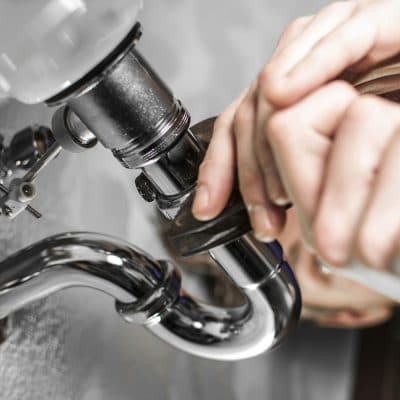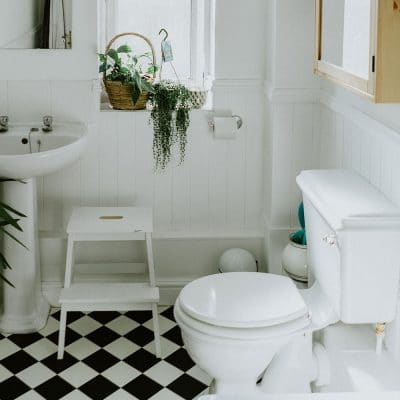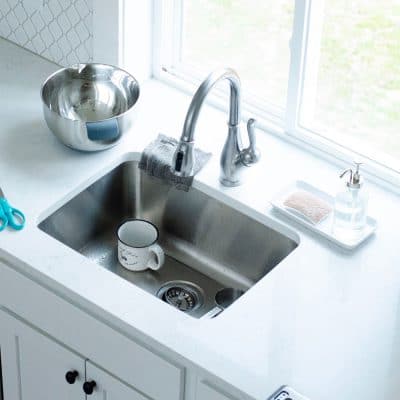Our most frequently asked plumbing questions:
 Got a clogged drain? We all know the feeling of wondering how much it will cost to clear the clog. The good news is that most clogged drain problems are usually easy enough to correct on your own without having to call a plumbing drain specialist. Try some of the following do-it-yourself household clogged drain tips that anyone can use before you call a plumber. It’s best to scoop out any standing water in the sink before you start for maximum effectiveness.
Got a clogged drain? We all know the feeling of wondering how much it will cost to clear the clog. The good news is that most clogged drain problems are usually easy enough to correct on your own without having to call a plumbing drain specialist. Try some of the following do-it-yourself household clogged drain tips that anyone can use before you call a plumber. It’s best to scoop out any standing water in the sink before you start for maximum effectiveness.
- Before attempting to use any harmful chemical products to clear a clogged drain, try this simple technique: Pour 1/2 cup of salt down the drain followed by boiling water. Continue to flush with very hot tap water until the clog is clear.
- Try pouring a cup of yogurt (without fruit) down the drain and leave it for several hours. The enzymes in the yogurt will sometimes eat away at the sludge that’s holding debris from washing through.
- To clear a hair clog, try pouring Nair hair remover into the drain. Let it sit for about a half an hour, then pour a little hot water down the drain. It will dissolve the hair and keep working on the gunk and hair further down the line as it continues to move down the pipes and drains.
- If you think it’s grease causing the clog, try pouring some dish soap (such as Dawn) down your drain. Let it sit for a while then follow it with a quart of boiling water and it should do the trick to unclog your drain. Be very careful with the boiling water to make sure you don’t splash it on yourself.
- For slow-running drains, try pouring a half box of baking soda down the drain, then dump in one cup of vinegar. It will bubble and foam, so you may want to cover with a towel. When it stops foaming, flush the drain with very hot water for 2-3 minutes.
- Plungers are not just for toilets. Try using one on your sink clogs. Be forceful and quickly press the plunger down over the drain obstruction. Hold it there a minute and then see if the clog is cleared. Repeat as necessary until the clog clears.
- If you’ve tried these simple home remedies and your drain is still clogged you can get a $30 drain clearing “snake” at your local plumbing or hardware store. Follow the manufacturers instructions carefully.
If all these tips fail you contact Zippy Zebra for some inexpensive drain cleaning services before it turns into a real problem!
The easiest way to see if you have a leak at your house or business is to check the water meter. The first thing Zippy Zebra recommends to do is to turn the water off at main shutoff to the house (if you have an old gate valve be careful as these easily break). You will also need to make sure your lawn sprinklers are off as well as any pool pumps. Once the water is turned off go back and check the meter. If the meter is moving and the water at the house is turned off you have a leak in the main line. If the meter is not moving then there is no leak between the meter and the house.
Now that you have determined there is not a leak between the house and the meter it is time to check and see if there is a leak inside the house. Turn the main shut off at the house back on. Before you go back to the meter go back in the house and make sure everything in the house (tub, shower, faucets, washer, dishwasher) are off. Once you have done this go back to the meter and see if the dial is moving. At first glance it may appear as if the meter is not moving, but if you mark it with a pen you may notice after a moment the dial is after all moving, just slowly. If the dial is moving this means you have a leak inside the house. It could be a toilet that is constantly leaking or it could be a slab leak.
Ninety percent of all leaks in residential plumbing systems are found in the toilet tank. Toilet tank leaks typically result from worn parts or improper alignment of some part of the flushing mechanism. It is very important to stop the leak. Stop the leak and stop the expensive water bill from hitting you every month.
If you suspect you have a leak in your system you should schedule Zippy Zebra as soon as possible.
Most hot water issues are due to a sediment buildup in your tank. If these deposits are not removed periodically, they create a barrier between the burner and the water, greatly reducing the water heater’s performance. Hot water heaters need to be drained occasionally to clear out the sediment. Be sure to follow the manufacturer’s instructions.
Electric water heaters commonly have two heating elements that work in turns. First the top element heats up the top of the tank, then the lower element kicks in. If the lower element is out, only the top of the tank gets heated. If the top element isn’t working, there will be no hot water at all. Try hitting the reset button.
If you would like some help with maintenance, repairs, or replacement of your hot water heater simply fill out the form at the bottom of the page!
 Toilet tank “sweating” is really condensation. It’s not coming from a leak in the plumbing system but rather from the air around it. Cold water in the tank and pipes causes them to cool down which in turn causes moisture in the air to condense on the pipes and tank. The condensation can drip on the floor and cause mold, mildew, staining, and eventually rotting if left untreated. Here are some simple solutions.
Toilet tank “sweating” is really condensation. It’s not coming from a leak in the plumbing system but rather from the air around it. Cold water in the tank and pipes causes them to cool down which in turn causes moisture in the air to condense on the pipes and tank. The condensation can drip on the floor and cause mold, mildew, staining, and eventually rotting if left untreated. Here are some simple solutions.
- There are foam insulation products which insulate the water from the tank. Most hardware stores carry these products for a reasonable price. Follow the manufacturer’s installation instructions carefully. This usually works but is not a guarantee.
- Another option is to install a mixer valve which mixes both hot and cold water to raise the temperature enough to stop the problem. You’ll most likely need to Contact us today for an appointment with one of our plumbers for installation.
- A very effective but more expensive option is to replace the guts of the toilet with a “pressure assisted” unit like the Flushmate – 1 gallon per flush. This option is a great water saver and works very well. You’ll have to get a Zebra plumber to install it.
Most leaks are caused by worn valve parts.
To fix a leaky faucet you first need to figure out what kind of faucet you have. If your faucet has a single handle you are dealing with a “washerless faucet” which has a cartridge, a ball or a disc mechanism to control the water flow. If your faucet has separate handle for hot and cold water you most likely have a compression faucet which has an internal shut off valve with a washer on the end. Some dual handle faucets have disc or cartridge mechanisms.
You’ll have to have enough skills and tools to open up the faucet and take the interior parts out for replacement. Your best bet is to take the interior parts to a plumbing supply or hardware store and have a salesperson help you find the proper replacement parts.
First, turn off the water supply to the leaky faucet. The shutoff valve is usually located under the sink but in some older homes there may only be one main water shut off for the entire house which is usually located where the water pipe enters the home.
Once the water is off, turn on the faucet until it stops running. Then, before you take apart the faucet plug the drain so you don’t lose screws, washers, or other parts down the drain.
Most faucet handles are attached with a screw which is hidden under a decorative cap that can be pried off with a small screwdriver. Then simply remove the valve parts inside the handle and take them to the plumbing supply store to get replacement parts. Install them according to instructions then turn the water back on and you’re done.
If you’re having trouble we’re glad to help. We also keep in stock a selection of modern and efficient replacement faucets that will save you money.
First, turn the garbage disposal on and off quickly and listen to see that it has power. If it hums, the power is on but the impeller is jammed. If it doesn’t hum, it may have overheated and tripped a circuit breaker.
Most disposals have an overload switch that trips when the motor overheats. If there’s no power to the motor, first look for a small red button on the bottom of the housing, and push it to reset. If there’s no overload switch or the machine still won’t run after you reset the switch, you might need to reset the circuit breaker that serves the disposal.
Many disposals have a manual mechanism for clearing a jammed blade. Look for an allen wrench socket in the bottom of the housing. Use the right size allen wrench (usually 1/4″) and move the motor shaft back and forth to dislodge the jam.
If this doesn’t work, try using the end of a short broomstick or plunger. Stick it down the drain and push back and forth against the impellers to clear the jam.
Is that still doesn’t work you’ll have to reach down inside and clear the jam by hand. First, and most importantly, turn off the circuit breaker that controls the garbage disposal to be sure that you don’t injure yourself. Then reach inside feel around to see what you can do to clear the jam by hand. You might need a pair of needle nose pliers to firmly grab whatever is lodged in the impeller.
If hitting the reset button doesn’t help, and you can’t clear a jam or can’t find what’s jamming it you might need to replace the unit. Contact us today for an appointment to come and take a look at it. We’ll give you a low, up front price to fix or replace it.
 Foul odors in sink drains are usually caused by rotting food, hair, grease, and or slime which build up over time in the drain. There are chemical drain cleaners you can buy at your local hardware store, but often times they are a temporary fix or do not fix the problem at all and can be very hard on pipes or the trim finish in your drain area. If the problem cannot be solved by taking apart the “pea trap” and removing the build up in your “smelly area“ call Zippy Zebra today for a FREE consultation.
Foul odors in sink drains are usually caused by rotting food, hair, grease, and or slime which build up over time in the drain. There are chemical drain cleaners you can buy at your local hardware store, but often times they are a temporary fix or do not fix the problem at all and can be very hard on pipes or the trim finish in your drain area. If the problem cannot be solved by taking apart the “pea trap” and removing the build up in your “smelly area“ call Zippy Zebra today for a FREE consultation.
Request an Appointment
If this is an emergency (flood or sewage back up), please call us at 480-820-6595. To request an appointment, please fill out the form below. Please note this is a request and a phone call to schedule an appointment receives first priority.
"*" indicates required fields
